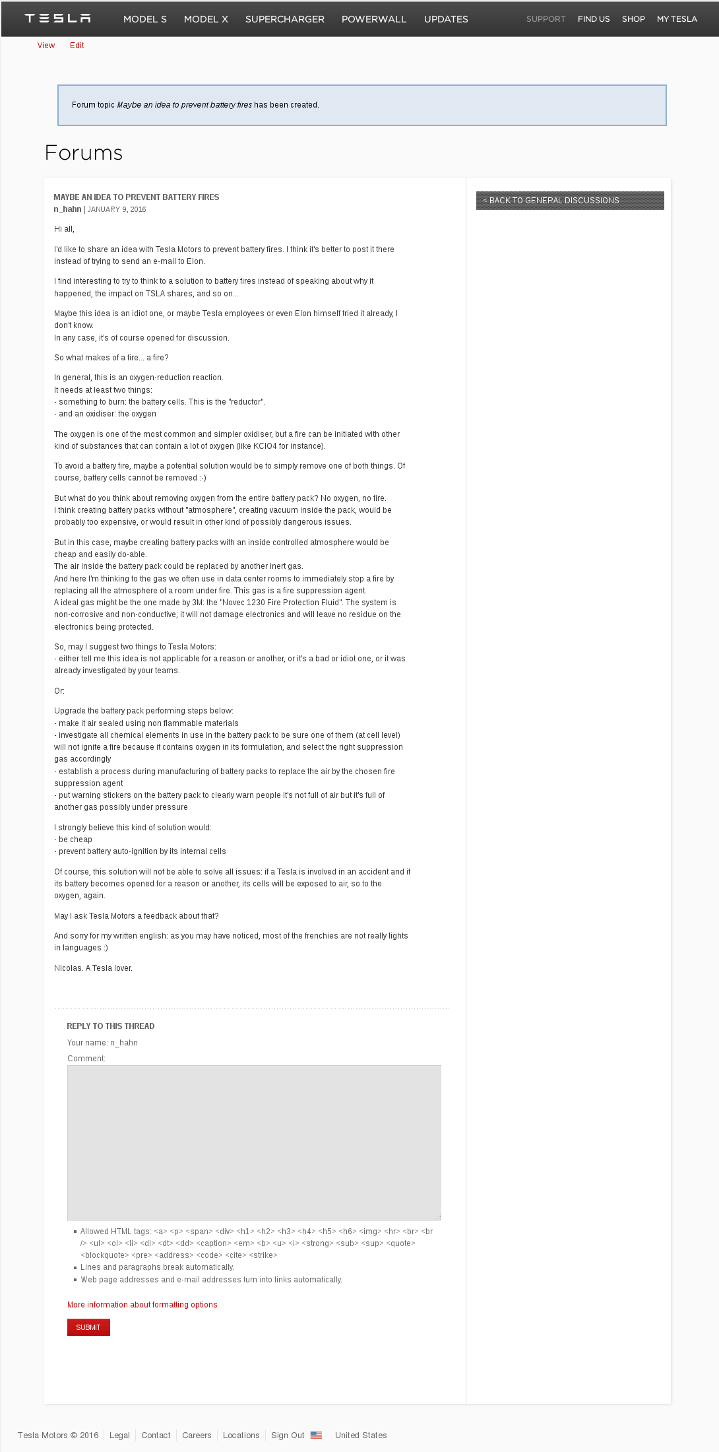Une solution possible pour prévenir les combustions spontanées de batteries pour véhicules électriques?
Par Nicolas HAHN le samedi 9 janvier 2016, 15:13 - Technologies - Lien permanent
Oula! Oui je sais je n'ai rien posté depuis un moment. C'est que je suis tellement occupé! Que mes fans me pardonnent ;-)
Pour me rattraper, voici un nouveau post au sujet des incendies spontanés des batteries des véhicules électriques. J'avais en effet envie de réagir par rapport à la calcination complète d'une Tesla Model S en Norvège au tout début de janvier 2016. Et comme je suis un "Tesla Lover", je ne peux pas permettre ce genre de chose vous comprenez :-)
Voici donc ci-dessous un post que je viens de rédiger en anglais sur le forum officiel des fans de TESLA: https://my.teslamotors.com/forum
J'y expose une idée, qui est peut être idiote ou qui a pu déjà être étudiée d'ailleurs chez Tesla. Voici la copie d'écran de mon post sur le forum TESLA. Si l'image est trop petite, j'ai recopié mon texte en-dessous.

Hi all,
I'd like to share an idea with Tesla Motors to prevent battery fires. I think it's better to post it there instead of trying to send an e-mail to Elon.
I find interesting to try to think to a solution to battery fires instead of speaking about why it happened, the impact on TSLA shares, and so on...
Maybe this idea is an idiot one, or maybe Tesla employees or even Elon himself tried it already, I don't know.
In any case, it's of course opened for discussion.
So what makes of a fire... a fire?
In general, this is an oxygen-reduction reaction.
It needs at least two things:
- something to burn: the battery cells. This is the "reductor".
- and an oxidiser: the oxygen
The oxygen is one of the most common and simpler oxidiser, but a fire can be initiated with other kind of substances that can contain a lot of oxygen (like KCIO4 for instance).
To avoid a battery fire, maybe a potential solution would be to simply remove one of both things. Of course, battery cells cannot be removed :-)
But what do you think about removing oxygen from the entire battery pack? No oxygen, no fire.
I think creating battery packs without "atmosphere", creating vacuum inside the pack, would be probably too expensive, or would result in other kind of possibly dangerous issues.
But in this case, maybe creating battery packs with an inside controlled atmosphere would be cheap and easily do-able.
The air inside the battery pack could be replaced by another inert gas.
And here I'm thinking to the gas we often use in data center rooms to immediately stop a fire by replacing all the atmosphere of a room under fire. This gas is a fire suppression agent.
An ideal gas might be the one made by 3M: the "Novec 1230 Fire Protection Fluid". The system is non-corrosive and non-conductive; it will not damage electronics and will leave no residue on the electronics being protected.
So, may I suggest two things to Tesla Motors:
- either tell me this idea is not applicable for a reason or another, or it's a bad or idiot one, or it was already investigated by your teams.
Or:
Upgrade the battery pack performing steps below:
- make it air sealed using non flammable materials
- investigate all chemical elements in use in the battery pack to be sure one of them (at cell level) will not ignite a fire because it contains oxygen in its formulation, and select the right suppression gas accordingly
- establish a process during manufacturing of battery packs to replace the air by the chosen fire suppression agent
- put warning stickers on the battery pack to clearly warn people it's not full of air but it's full of another gas possibly under pressure
I strongly believe this kind of solution would:
- be cheap
- prevent battery auto-ignition by its internal cells
Of course, this solution will not be able to solve all issues: if a Tesla is involved in an accident and if its battery becomes opened for a reason or another, its cells will be exposed to air, so to the oxygen, again.
May I ask Tesla Motors a feedback about that?
And sorry for my written english: as you may have noticed, most of the frenchies are not really lights in languages :)
Nicolas. A Tesla lover.